Coney Island - Disasters, Spectacles & Cycloramas
The material is copyrighted © 1998 by Jeffrey Stanton.Revised April 7, 1998
George C. Tilyou once wrote, "If Paris is France, then Coney Island, between June and September, is the world." This was undoubtedly true, especially at the turn of the century, when visitors could take make believe journeys around the world, even to the moon and beyond. It was in an age before motion pictures became established as the dominant art form, and the few images included in newspaper accounts of disasters and wars were often poor renditions of the original event.
Various Coney Island showmen were quick to satisfy the public's morbid curiosity to experience reenactment of the world's calamities. Soon there were shows depicting the Galveston Flood, the volcanic eruption of Mont Pelee, and the naval battle of the Russo-Japanese War.
Disasters
One of the earliest disasters to be recreated at Coney in 1902 was the Galveston Flood. It had been a devastating catastrophe for the Texas resort town in September 1900. Most of the town was barely above extreme high tide when a tidal surge driven by an advancing hurricane caught its indifferent populace by surprise. Winds of 125 MPH and a 15.2 foot flood nearly leveled the entire town and killed 6000 people out of an estimated population of 37,700. Property losses were $20,000,000 and another 5000 people, living in adjacent shoreline areas perished.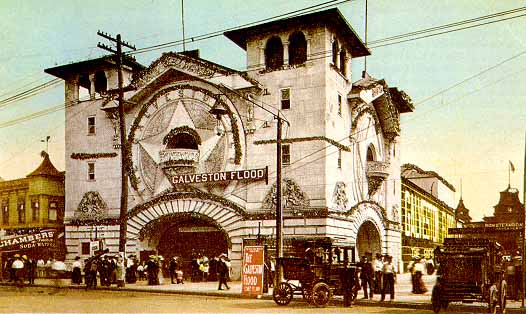
| The Galveston Flood Building |
The show was housed in a large building on Surf Avenue at 17th Street. The city and harbor were recreated in miniature with model buildings. Then through a combination of real and fake water, large sheets of painted cotton fabric, intricate lighting and mechanical effects, the city was transformed into a state of utter destruction. A lecturer explained the sequence of events to the audience.
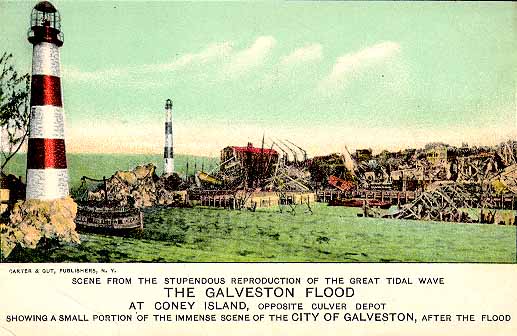
| View of the destruction after the flood. |
The Johnstown Flood was another popular disaster show that played nearby. The city had been a bustling industrial area located in a deep valley about 60 miles east of Pittsburgh. In May 1889 after eight inches of heavy rain, a dam located fourteen miles upstream burst and sent 20 million tons of water down into the valley towards the unsuspecting town. A dam worker had tried to telegraph a warning to the town shortly before the dam's collapse but the lines were down. The wall of water took almost an hour to reach the Johnstown, and by the time it got there it had become a gigantic mix of people and animals, uprooted houses, schools, factories, 30 train locomotives and cars, entire bridges, and nearly every tree in the valley. Most of the town's buildings were swept away in the flood and at least 2,200 people died with almost 1000 more missing and never found.
Mount Pelee on the Caribbean island of Martinique began its volcanic eruption in late April 1902. Ash began to fall on the nearby city of St. Pierre. At first the city's inhabitants weren't too concerned, but some began to send their woman and children to safer ground as the volcano became more active. Finally on May 8th at 7:52 A.M. the mountain's upper flank facing the city opened and an intensely hot cloud of black vapor shot out towards the city like smoke from the muzzle of a cannon. In less than a minute the hot gas, a mixture of super heated steam at 1900 degrees, lethal gases and explosive dust, reached the city and everything in it burst into flame. At the same time a second black cloud rolled upwards and spread darkness for fifty miles across. Of the 30,000 people trapped in the city only two survived. The city itself burned for days. The show's auditorium seated 1200 people and was equipped with 11 exits to assure safety in the event the pyrotechnic display got out of control and set the building afire.
The San Francisco Earthquake occurred on April 18, 1906 at 5:13 A.M. when the San Andreas Fault shifted and caused a violent earthquake with unbelievable power. While many of the city's brick and wood framed buildings still stood or were only moderately damaged, 50 fires broke out within minutes. Fire fighters soon found out that the water mains were shattered and were powerless to stop the fires. By the following afternoon and the fire completely out of control they began dynamiting a 175 foot wide fire break, one mile long in order to save the city west of Van Ness. By the time the fires were finally out two days later the city was in ruins with 28,188 buildings destroyed in 512 blocks. 500 people were crushed or trapped and burned to death and another 350 were missing and never found. Insurance claims totaled $299 million and a lot of the buildings were uninsured.
San Francisco's catastrophe captivated the American public. Never before, at least in modern times, had a major American city been destroyed by nature. Dreamland's management felt that they had a winner when they staged the disaster that summer. The show was actually in three parts; its historic gold seeking days, general views of the city, and finally its destruction by earthquake and fire.
The Fall of Pompeii was an attraction at Dreamland in 1904. Visitors seated inside a classical Greek temple decorated with a fresco of a dormant volcano watched the eruption of Mt. Vesuvius and its destruction of the town of Pompeii and its remaining inhabitants. The effect was achieved with scenic and mechanical equipment and an exciting electrical display finale.
Another disaster illusion designed and staged by Thompson at Luna Park in 1904 was called Fire and Flames. It had its auditorium arranged that spectators were seated on the other side of the street from a burning four story building. Luna hired hundreds of firemen to fight imaginary flames. A rescue squad arrived to save actual men and women trapped in the building's top floors, who jumped to safety into the nets below. Luna was the first park to present a live spectacular show.
In Dreamland's similar, more elaborate and most exciting show, Fighting the Flames, there was the noisy arrival of the fire fighting apparatus, followed by breathtaking rescues of people trapped in the building's upper stories. Spectators watched from bleachers just inside the buildings ornate facade decorated with sculptures of fire fighters. A cast of 2000 fire fighters, complete with four engines and hose wagons, an extension ladder fire truck had to save a full-sized six-story hotel constructed of iron that was set on fire.
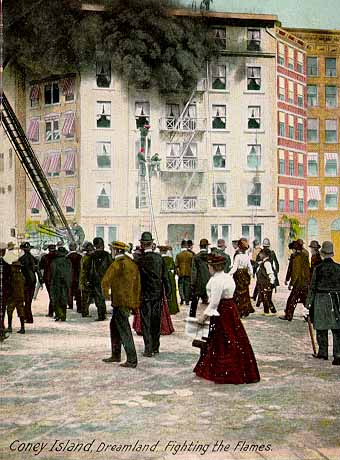
| Dreamland's Fighting the Flames |
Spectacles
The greatest staged spectacle at Coney Island was the Boer War show that played on a patch of swampland between Manhattan Beach and Brighton Beach during the summer of 1905. The show had been assembled by Alfred W. Lewis for the 1904 St. Louis World's Fair. Lewis convinced a number of both British and Boer veterans of the South African war to restage the pivotal battle. History majors will probably remember that the British fought a war against the Dutch Boers for control of all of South Africa from 1899 to 1902. In February 1902 the world famous Boer leader, General Piet Cronje, who had practiced guerrilla war against the British, surrendered his citizen army of 5000 brave soldiers to Lord Roberts' overwhelming force at the Modder River in the Orange Free State. Lewis managed to convince Cronje to join his paramilitary force for the reenactment.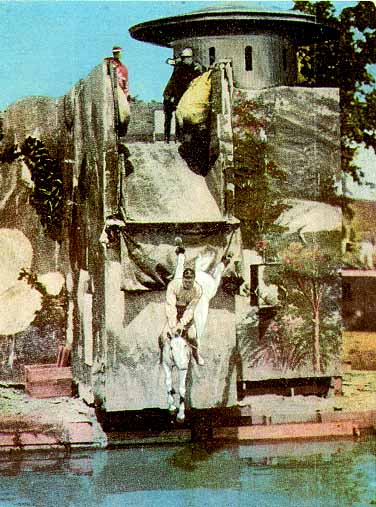
| The Boor War spectacle was action packed. -1905 |
When the fair ended the show went on the road. It toured the South during the winter and played to very light crowds. When it went broke, the New York showman, William Aloysius Brady wired enough money to bring the show to Coney Island.
During the chilly early spring one thousand men erected a grandstand that could seat twelve thousand people while fifty eight artists painted hundreds of yards of canvas. Meanwhile tin-smiths soldered together a huge zinc trough that when filled with water would become the Modder River.
When the 600 actors arrived from the south in boxcars, they were a sorry looking bunch; cold, starved, smelly and fighting mad. A military camp had been set up for the men and they could get clean in the nearby ocean. Brady had trouble establishing authority with the often drunken men, until one day he kicked a foul-mouthed Boer in the solar plexus. After that things went smoothly.
Brady beefed up his armies with locals so by opening day, 1000 troops took the field. The show began with a few British scouts riding into an ambush. A full scale battle quickly ensued with cannons roaring away and battalions of soldiers firing blanks at each other. One of the highlights was the recreation of General Christian de Wet's lucky escape on horseback when the British caught the cavalryman napping.
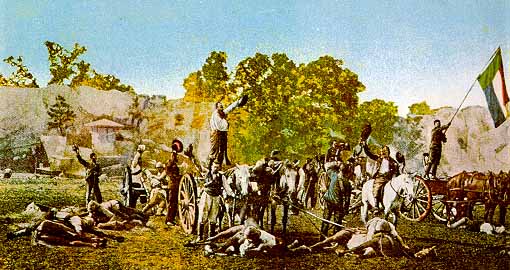
| The Boor War finale was the surrender of General Cronje and his troops. |
It was a great show and a success that summer of 1905. Its only problem was that its big guns made the race horses at nearby Brighton Beach racetrack skittish. So at post time the spectacle of war would pause for a minute and its guns would fall silent while the horses ran their race.
The Great Deluge Spectacle opened in the old Johnstown Flood building opposite Steeplechase during the summer of 1906. The Biblical show was performed in three acts by a cast of 50 people while a lecturer narrated the spectacle. The show began in a great temple, set in the erotic period and was modeled after Gustave Dore's conception of Milton's "Paradise Lost." The characters at the temple, instead of worshiping God, were drinking, dancing and indulging in wanton pleasure. When the patriarch appeared to warn them of the coming flood and mend their ways, all they did was laugh and make fun of Noah. When the old man left, they became more defiant of Noah's God and celebrated even more. At that instant a peal of thunder signaled the beginning of the rains and the flood descended, drowning all. The ark was seen in the distance surrounded by a halo of light.
As the ark gradually approached, the water receded and the ark landed on Mt. Ararat. The ramps were lowered and the animals filed out in a procession, two by two. Noah and his family followed and kneeled before God in thanks. The last scene showed the millennium. Angels appeared on either side of the stage, and other angels floated through the air.
The Fall of Adrianople was a spectacle staged at Luna Park in 1913 on a stage 475 x 175 feet. They built a Turkish city with mosques, bazaars, minarets and embattled castle. There was a fort with twelve inch guns and a mountain backdrop. An army of invading Bulgarians, Serbs, Montenegrens and Greeks bombarded the Turks, then stormed the fort. The finale was the surrender of the garrison. It was performed for one year only before an audience of 1800 seated in a grandstand. It cost $25,000 to stage.
Henry J. Pain, who came to Coney Island from England in the 1880's, was so successful at staging fireworks extravaganzas at Manhattan Beach, that he built a permanent grandstand at Brighton Beach. His shows had simple plots that featured disasters such as the eruption of Mount Vesuvius burying Pompeii and naval battles like the annihilation of Russia's defenses at Vladivostok. Scores of actors took part in the performance, but the spectacle was watching towns and fleets destroyed by torrents of magnesium powder and violent yet noisy explosions.
Cycloramas
Cycloramas were shows in cylindrical rooms or buildings with the spectators seated in the center. A large canvas, in natural perspective showing a landscape, a battle, or some other scene, surrounded them. Sound and electrical effects were often used to highlight the action.A Trip to the Moon was housed in a large round building at Steeplechase when it debuted at Coney Island in 1902. The following year it was transferred to Luna Park during its opening season. Sixty passengers would board a large raised winged spaceship where they sat on steamer chairs on an open deck. They could watch the ship's liftoff and flight to the moon through portholes in the walls and floor of the room. Scenes painted on movable canvas screens gave the riders the illusion of liftoff from the fairground, flight past Niagara Falls then up into space away from a shrinking Earth. The ship slowly rocked and wind blew from hidden fans while cables and rods linked to motors made the ship's huge wings slowly flap. En route to the moon, travelers encountered a fierce electrical storm with thunder, lightning flashes and whistling wind. The ship would then approach the moon and fly over its canyons and craters before making a landing.
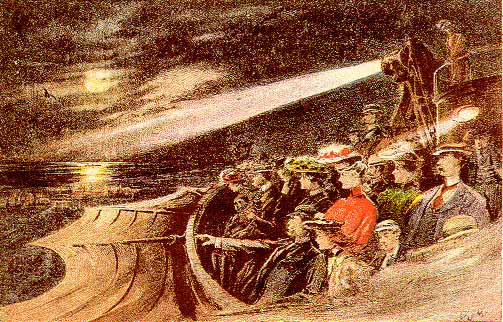
| Thompson's Trip to the Moon. - 1903 |
The debarking passengers now within the crater of an extinct moon crater were greeted by Midget "Selenites" with spiked backs. They were led down a long illuminated avenue filled with toadstools and fantastic trees to the City of the Moon and beyond the moat to the castle of the Man in the Moon. Finally moon maidens escorted the visitors into the green cheese room where they would offer them tasty pieces of cheese off the walls. Passengers returned to Earth via a swaying bridge.
Another of Thompson and Dundy's cyclorama shows in 1904 was The Great Naval Spectatorium, soon renamed War of the Worlds. The audience was seated in one of the batteries guarding New York. From that vantage point they watched the combined navies of Germany, Britain, France and Spain sail over the horizon towards Manhattan. But before they could lay siege to the city, the American fleet intercepted them and sank every one of the enemy ships. The show used a combination of actors and models, while in the background, the huge painted canvas showed the harbor and Statue of Liberty. When the public became tired of the show, it was replaced with other naval engagements. First came the Fall of Port Arthur in the Russo-Japanese War, and in 1907 the Great Shipwreck. The later show dealt with the sacking of Henlopen, Delaware by Captain Kidd's brother. There was a moral to the 11 minute show as the pirates got their due when a sudden storm came up and drove their unattended ship "Corsair" on the rocks.
The Battle of the Merrimac and the Monitor had been the most popular attraction at the Jamestown Exhibition when Luna Park installed it in 1908 in the Trip to the Moon building. It featured the Civil War naval battle between the South and the North's two ironclads. These were the first totally armored ships.
After a two year run, it was replaced by Thompson's newest creation, A Trip to Mars by Aeroplane. Thirty passengers were transported on a trip that began at Governor's Island. The plane, seemingly under its own power, sailed through the clouds up towards the stars. A lecturer on board narrated the sights on the Martian odyssey. It would sail to several stars before returning to Earth.
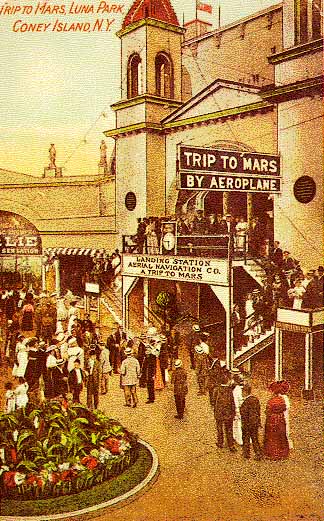
| Thompson's A Trip to Mars by Aeroplane |
One of the final cyclorama shows was Little America at Luna in 1930. It featured a painting of the new world at the south pole that was 350 feet in circumference and 50 feet high. The canvas was animated with electrical effects and realistic moving figures of icebergs, native inhabitants and dog sled teams.